Modèles opérationnels
Le rapport « La situation mondiale des transferts monétaires » du CALP Network identifie plusieurs types de modèles opérationnels, dont les consortiums et les alliances, les mécanismes de distribution des transferts partagés, un modèle de distribution des transferts monétaires articulé autour d’une seule organisation et l’intégration de systèmes.
« La structure générale au sein de laquelle les organisations travaillent conjointement […] pour distribuer les transferts monétaires […] lors d’interventions et d’activités d’analyse, et de la conception et de la mise en œuvre de programmes. »
Notre définition d’un modèle opérationel
Accroître l’échelle des transferts monétaires permet de transformer la manière dont l’aide humanitaire est distribuée. Cette décision a des conséquences sur les rôles des organisations dans le cadre de plusieurs modèles opérationnels, et sur la capacité des modèles à établir un lien avec les systèmes de protection sociale. Un changement d’échelle aura également un impact sur les partenariats avec des fournisseurs de technologies et de services financiers et sur la manière dont différents modèles interagissent avec d’autres formes d’assistance.
Priorités actuelles
Depuis fin 2016, le CALP Network assure la coordination d’un programme d’apprentissage visant à répondre aux questions suivantes :
- Quels sont les modèles opérationnels disponibles pour les organisations mettant en œuvre les transferts monétaires ?
- Comment différents modèles ont-ils amélioré l’efficience, l’efficacité et la transparence des transferts monétaires dans divers contextes ?
- Quels sont les modèles opérationnels les plus appropriés dans chaque contexte ?
Nous continuerons de compiler et diffuser notre base de données probantes sur les modèles opérationnels.
Nous sommes également partenaire du consortium Cash Monitoring, Evaluation, Accountability, and Learning Organizational Network (CAMEALEON), piloté par le Conseil norvégien pour les réfugié·es, qui est responsable du suivi et de l’évaluation indépendantes du programme d’assistance monétaire à usages multiples du PAM au Liban. À ce titre, nous menons des recherches et des analyses concernant l’optimisation des ressources et la redevabilité au sein du modèle opérationnel.
Contenu présenté

Operational Models: Accountability to affected people
Webinar

MEAL in Emerging Operational Models
Webinar

CTP Operational Models Analytical Framework
Guidelines and Tools
The State of the World’s Cash Report launched by the CALP Network in February 2018 highlights trends in the uptake of various operational models for the delivery of cash at scale in humanitarian response. Current decision making on the choice between these various operational models is highly influenced by context, and by the policies and approaches of donor agencies. Decision making on...
Thematic lead
Contenu récent

2020 Cash and Voucher Programming (CVP): Roadmap and milestone achieved
Report
In 2020, World Vision has implemented cash and voucher programming like never before – not least due to the COVID-19 pandemic and related social protection transfer scale-ups. From 2019 to 2020, we have seen a 28 % increase of our cash, voucher based programming, moving towards enabling affected...
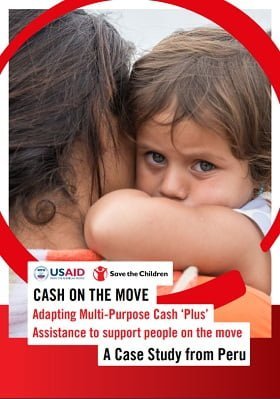
CASH ON THE MOVE – Adapting Multi-Purpose Cash ‘Plus’ Assistance to support people on the move in Peru
Report
In 2019 and 2020, with the support of USAID´s Bureau for Humanitarian Assistance (formerly FFP and OFDA), Save the Children implemented
a multi-purpose cash ‘Plus’ program in response to the influx of Venezuelan migrants into Peru.
Households that were only transiting through the cities where they...

Dossier stratégique du cluster mondial pour l’éducation liste de contrôle sur les transferts monétaires
Guides et outils
La présente liste de contrôle fournit des orientations qui vous aideront à envisager les modalités d’exécution des transferts monétaires tout au long du document de stratégie du Cluster et du processus d’élaboration de celle-ci, de la même façon que pour l’aide en nature. Les transferts...

Cash and Voucher Assistance Guidelines for Lao PDR
Guidelines and Tools
Cash and voucher assistance is becoming increasingly popular in Lao PDR in delivering humanitarian assistance, rehabilitation and development focused projects. In supporting the cash and voucher assistance agenda in Lao PDR, the Cash Working Group was established as a working group for local and regional...

Safer Cash Toolkit (Français)
Guides et outils
La trousse pour une gestion sûre des espèces a été conçue dans
le but d’apporter une solution au problème de manque de données
pour l’évaluation systématique des risques encourus par les individus
qui reçoivent et utilisent l’assistance en espèces de programmes
humanitaires. Cette trousse...

Cash Assistance: How design influences value for money – How to note
Guidelines and Tools
This ‘how to note’ offers guidance on the key value-for-money considerations when making critical design decisions related to the operational models for CVA delivery. The guidance in this ‘how to note’ is summarised from the evidence presented in the accompanying research report Cash assistance:...

Cash assistance: how design influence VfM?
Blog Post
Watch the video here
In a context where the needs are increasing and funding is likely to drop, how do we make sure that every penny is bringing value to the users?
This short video presents the main findings of the Key Aid report on the question of how specific design decisions related to cash assistance...

Cash assistance: how design influence VfM?
Video
Watch the video here
In a context where the needs are increasing and funding is likely to drop, how do we make sure that every penny is bringing value to the users?
This short video presents the main findings of the Key Aid report on the question of how specific design decisions related to cash...

Cash assistance: How design influences value for money?
Report
This research aims to contribute to the proof-of-concept on how to design and deliver cash assistance that aligns with end-users’
expectations and maximises Value-for-Money. It seeks to answer the question: to what extent is the value for money of cash assistance influenced by the design of the...

Summary: Lessons and Recommendations on the Use of CVA for the Caribbean Atlantic Hurricane Season
Report
This is a summary document of the CALP Network’s Winds of Change: Lessons and Recommendations on the Use of CVA in the Caribbean and includes a matrix of learning and evidence from the region used to inform the report. This document is made possible by the generous support of the American people...
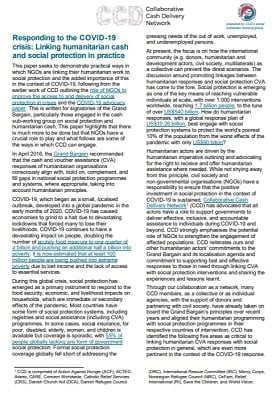
Responding to the COVID-19 Crisis: Linking humanitarian Cash and Social Protection in practise
Report
This paper seeks to demonstrate practical ways in which NGOs are linking their humanitarian work to social protection and the added importance of this in the context of COVID-19, following from the earlier work of CCD outlining the role of NGOs to
improve the access to and delivery of social protection in...

Identifying practical options for linking humanitarian assistance and social protection in the COVID-19 response
Guidelines and Tools
This short note examines the relationship between humanitarian assistance and social protection in response to COVID-19. Whilst a variety of guidance is being developed to support humanitarian practitioners around the response to the pandemic, less material exists that guides humanitarian practitioners on...

Review and analysis of identification and registration systems in protracted and recurrent crises
Report
This report presents findings from a study regarding Management and Information Systems (MIS) used to identify and register target populations in cash transfer and social protection programming. The research was conducted by DAI and Caribou Digital, and commissioned through DFID’s BASIC programme. The...

Collaborative Cash Delivery Network – Grand Bargain – Collaboration Agreement Accomplishments 2020
Report
The Collaborative Cash Delivery (CCD) Network is pleased to present its achievements against the commitments made by our global members’ CEOs at the 2019 Grand Bargain Summit as part of our global collaboration agreement. We know we are better together, and in this time of increasing pressure on the...

MPCA ‘Plus’ assistance to people on the move: the case of Venezuelans in Peru
Video
Watch the video here This video documents the MPCA ‘Plus’ program implemented by Save the Children Peru in response to the Venezuelan crisis, and more specifically highlights the provision of assistance to families on the move, or ‘transiting’ through Peru. Beneficiaries were identified throughout...
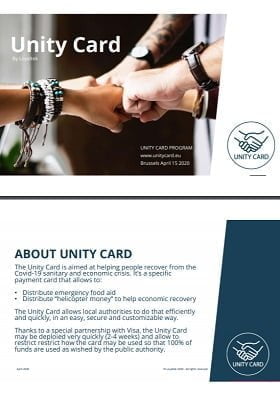
Unity Card
Presentation
In response to NCOVID, we have launched UNITY CARD,
which gives immediate technical support to the deployment of cash aid via this special card payments

Webinar | Multi-purpose Cash Transfer and Child Protection: a case study (English and Spanish editions)
Webinar recording
Watch the webinar recording here. More information here. In 2018, with the support of OFDA and FFP, Save the Children implemented a multi-purpose cash transfer ‘Plus’ program in response to the influx of Venezuelan into Colombia. The program aimed at covering vulnerable household’s basic needs and...
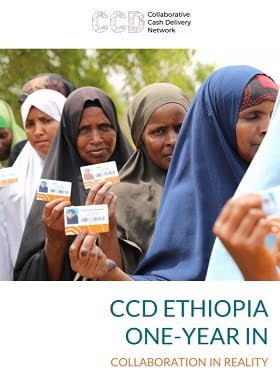
CCD Ethiopia one-year in: Collaboration in reality
Report
Based on insights compiled from surveys and interviews conducted with members of the Ethiopian cash community and CCD (Collaborative Cash Delivery Network) members in January 2020, this report provides an overview of how CCD Ethiopia is working towards global and national objectives, takeaways for startup...

LOUISE Learning Review
Report
This report presents the outcomes of the learning review on the Lebanon One Unified Inter-Organizational System for E-cards (LOUISE) platform commissioned by UNICEF on behalf of the LOUISE agencies (WFP, UNHCR, UNICEF) in 2019 to build on the LOUISE experience and conduct a stock-taking exercise. The...
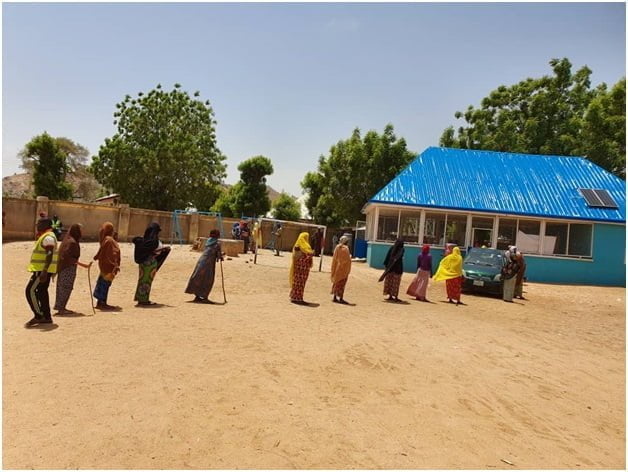
COVID-19 and CVA: how are operational actors responding?
Blog Post
“The COVID-19 pandemic will have devastating consequences on people’s livelihoods and employment, especially in post-fragile, crisis and post-crisis environments.” Global Humanitarian Response Plan: COVID-19 We don’t yet know exactly how the COVID-19 pandemic will be experienced by the world’s...



